.png)
.png)
Are you new to SAP? Take a look at the company and its solutions in this overview. SAP stands for Systems, Applications, and Products in Data Processing, and the company is a leading publisher of enterprise application software for business use. Headquartered in Walldorf, Germany, the company provides services and products to over 400,000 customers in 180-plus countries.
SAP was founded in Mannheim, Germany in 1972 by a group of IBM colleagues: Dietmar Hopp, Hans-Werner Hector, Hasso Plattner, Klaus Tschira, and Claus Wellenreuther. Their goal was to create real-time business software for companies; they started with financial accounting and would eventually expand outward to other areas of business.
The software at the center of SAP’s first financial accounting solution was termed the R/1 system. Its adoption provided enough funds for the company to continue developing updated and newer features; by the end of the 1970s, the R/1 system was overhauled and released to the public as R/2. New to this iteration was a database and dialog control system.
SAP grew its market share during the 1980s; at one point, half of the top 100 German companies used SAP software in their organizations. Eventually, international offices were opened to sell products to other markets, and by 1990 subsidiaries were located in Austria, Denmark, Sweden, Italy, and the United States.
The 1990s saw more growth for the German company, from becoming listed on the New York Stock Exchange to introducing its third-generation enterprise computing software. R/3 provided more front-end accessibility for end users and ran on a new three-tier client/server architecture. During this decade, SAP also began integrating its products with e-commerce and web technologies in a partnership with Microsoft.
By 2004, SAP was the third-largest software vendor in the world, behind Microsoft and IBM. In order to stay on the cutting edge of ERP software, SAP employed a two-pronged strategy: the first was to release a new flagship application, SAP ERP Central Component (SAP ECC, but regularly shortened to SAP ERP—which will be used in this document going forward). The second was to look to the future by creating a revolutionary new way to do business. Co-founder Plattner led this team as they searched for the answer to the question, “How do I get business questions answered the moment they’re asked?”
In 2010, SAP had its answer, one that would be its biggest contribution to the computing industry: the in-memory database known as SAP HANA. In the eight years following its general availability release in 2011, more than 30,000 customers began utilizing SAP HANA.
SAP HANA would also serve as the foundation of a new flagship product. Launched in 2015 with a set of robust financials capabilities, SAP S/4HANA was announced as SAP’s replacement for SAP ERP. Additional lines of business (LoBs) have been added to SAP S/4HANA since 2015; there are currently nine LoBs released or in development.
In the 2010s, SAP also looked to expand its offerings by acquiring a number of existing products to fill gaps in market coverage or that could be used in tandem with existing SAP solutions to add more functionality to the SAP S/4HANA solution. Starting in 2010, SAP acquired numerous market-leading products, including hybris, Ariba, Concur, SuccessFactors, BusinessObjects, and Signavio.
As of 2023, SAP is heavily focused on enhancing SAP S/4HANA with reporting and analytics tools, providing automation options for business processes, exploring ways to leverage IoT and machine learning technologies, and adding generative AI to its solutions with tools like Joule.
SAP offers products for a wide range of industries and business processes, from leading oil and gas production firms to sports teams to product-and service-based companies. This means, in theory, that anybody doing business should be able to find something from SAP that can help them run their business better.
SAP offers licenses of individual solutions for companies who need help in just one functional area, provides full-suite platforms for companies that choose to operate all business with SAP software, and publishes new updates quarterly (for cloud-based systems) or annually (for on-premise systems) for customers.
SAP currently maintains two expansive ERPs (oftentimes referred to as “Business Suites”) for its customers: SAP ERP and SAP S/4HANA.
SAP ERP is SAP’s legacy business suite. Building off the R/1, R/2, and R/3 solutions, it was this application that first integrated with the internet on a large scale. Customers using SAP ERP can run it on any platform they’d like.
With the release of SAP S/4HANA, SAP is preparing to sunset SAP ERP. Customers can expect maintenance and occasional updates of core applications through 2027 with some additional, extended maintenance planned through 2030.
As a complete platform, SAP ERP consists of transactional and analytical systems. Below provides a brief definition of each core area.
Sometimes there is confusion around the terms SAP and ERP and whether they mean the same thing. ERP is, generally, enterprise resource planning software that helps businesses perform their activities. SAP is one of many vendors of ERP software. SAP ERP is the option that SAP offers to customers.
The SAP Enterprise Resource Planning application focuses on financial, human capital, operational, and corporate services. This includes both financial and managerial accounting, personnel information and career development processing, day-to-day business operations, and external activities such as travel management.
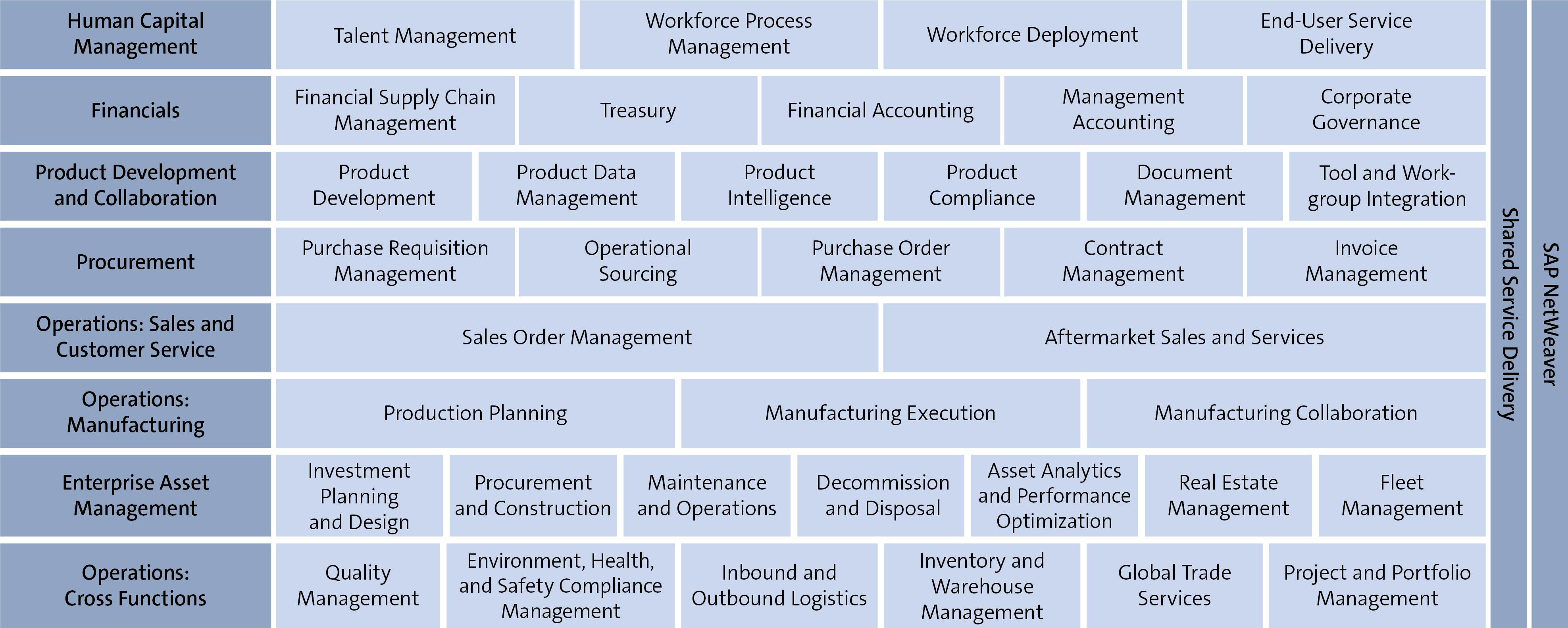
Note that SAP ERP in this case refers to an application and not the business suite known as SAP ERP Central Component (ECC, also SAP ERP). To avoid confusion, a good rule of thumb is to assume that when SAP ERP is being mentioned on its own (“we run SAP ERP and are moving to SAP S/4HANA”) that SAP ECC is being referred to, and when SAP ERP is followed by a specific system (“we run SAP ERP FI-CO in the organization”) that the SAP ERP application is being referred to.
SAP Customer Relationship Management (SAP CRM) focuses on customer management. This includes areas such as marketing, sales, service, and e-commerce. By using SAP CRM, businesses can keep in touch with customers and learn how to best serve them.

SAP Supplier Relationship Management (SAP SRM) focuses on the procurement process and the different stakeholders involved. This includes monitoring and measuring the efficiency of suppliers and vendors, tracking procurement activities, sourcing assignment of orders, managing contracts and invoices, and more.

SAP Product Lifecycle Management (SAP PLM) focuses on the products a business offers from conceptualization to sunset. Operations such as portfolio planning, research and development, and manufacturing are considered tasks to complete with SAP PLM.

The SAP Supply Chain Management (SAP SCM) tools help businesses meet market demand. Activities include planning stock levels, manufacturing products from raw materials, fulfilling orders, transporting finished products, and collaborating with suppliers and other vendor partners.
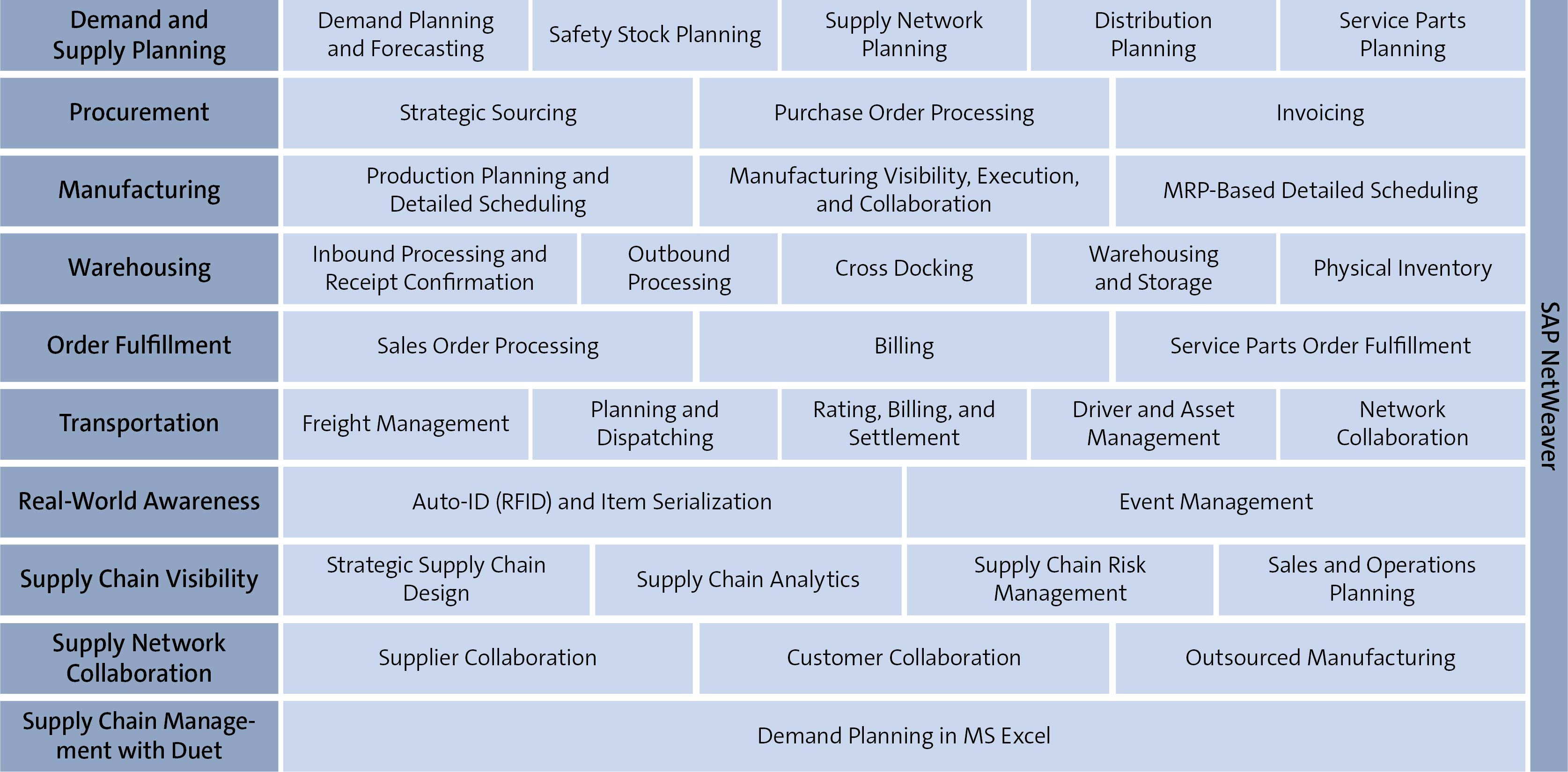
SAP S/4HANA is SAP’s current enterprise application suite. First released in 2015, the platform was the biggest change to SAP’s core offerings since the introduction of the R/3 system in 1992.
Among the key changes from SAP ERP were the utilization of SAP HANA’s in-memory computing architecture, the ability to gain real-time business statistics and analytics, and the convergence of transactional and analytical systems into one.
In addition to this, SAP used the product’s launch to reallocate some of the individual modules of SAP ERP into new lines of business (LoBs). As of 2023, SAP S/4HANA’s current or planned LoBs are listed below.
The SAP S/4HANA Finance LoB focuses on all money-related activities of a business. This includes financial accounting, controlling, treasury and risk management, financial planning, financial close, and consolidation. Learn more about SAP S/4HANA Finance here.

SAP breaks down logistics processes into four different LoBs rather than lumping them into the Supplier Relationship Management and Supply Chain Management categories as SAP ERP does. Learn more about SAP S/4HANA’s logistics capabilities here.
The SAP S/4HANA Sourcing and Procurement LoB focuses on the activities surrounding the obtainment of raw materials needed to fulfill orders. This includes extended procurement, operational purchasing, and contract and supplier management.
The SAP S/4HANA Manufacturing LoB focuses on the product creation process. This includes responsive manufacturing, production operations, scheduling and delivery planning, and quality management.
The SAP S/4HANA Supply Chain LoB focuses on overall business planning activities, from pre-planning production runs to dispatching products to purchasers. This includes production planning, batch traceability, warehousing, and inventory and transportation management.
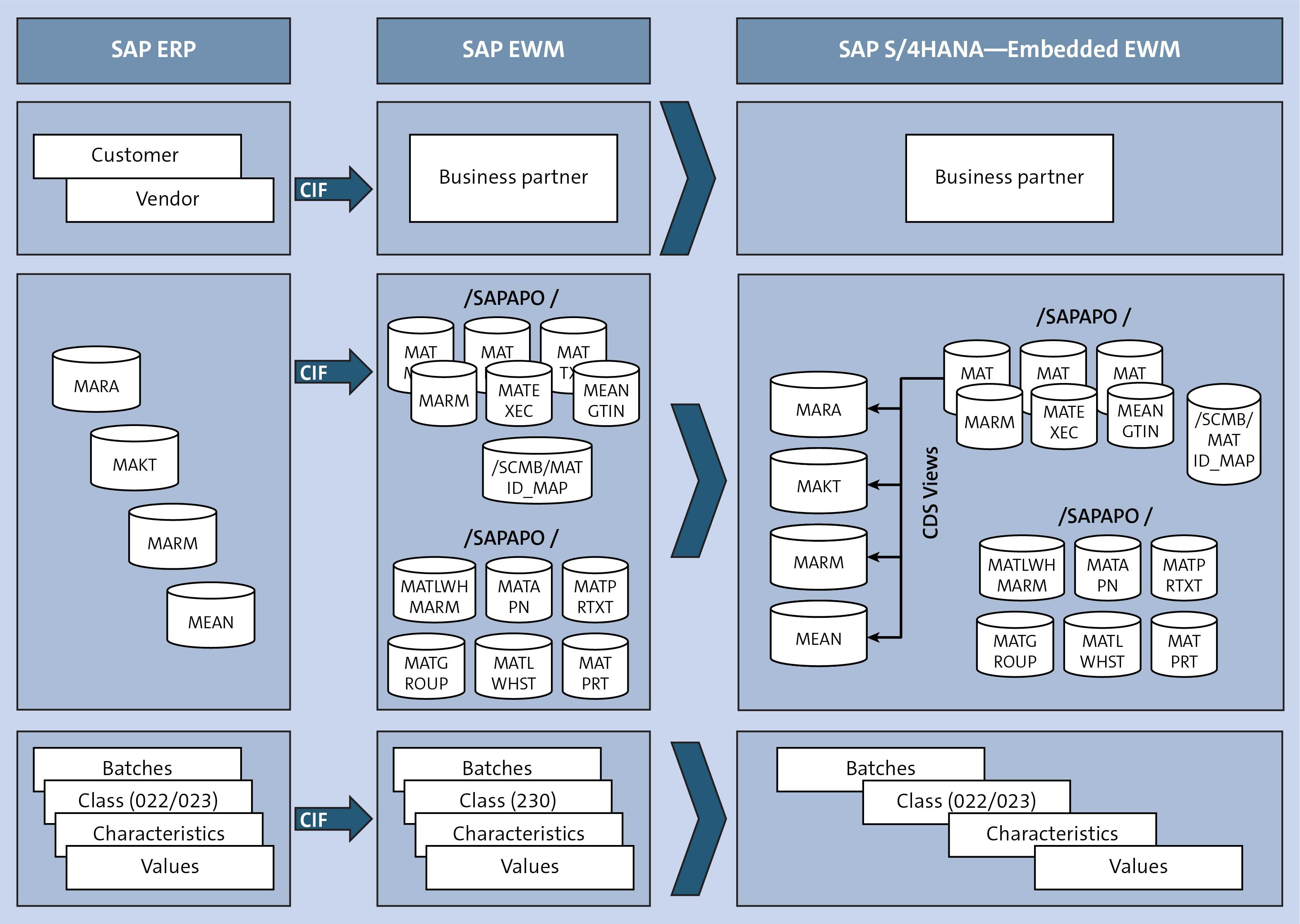
The SAP S/4HANA Asset Management LoB focuses on the maintenance of a business’ fixed assets, from smaller assets such as tools all the way up to buildings. This includes plant maintenance and EHS monitoring.
The SAP S/4HANA Sales LoB focuses on the activities associated with the buyers’ decision process. This includes pricing, sales inquiries and quotes, sales contracts and agreements, free-of-charge orders, available-to-promise checks, incompletion checks, repair orders, individual requirements, return authorizations, credit and debit memo requests, picking and packing, billing, and revenue recognition.
The SAP S/4HANA R&D LoB focuses on the lifecycle of a product. This includes defining the product structure and bill of materials, product lifecycle costing, managing portfolios and projects, managing innovation, managing chemical data and other sensitive materials used in development, and staying compliant with safety and health regulations.
The SAP S/4HANA Human Resources LoB is currently being developed by SAP, with an on-premise solution being planned. In the interim, customers can utilize either SAP SuccessFactors for a cloud-based HR services or SAP ERP HCM for an on-premise alternative.
In summer 2018, SAP announced a suite of customer experience management solutions under the moniker SAP C/4HANA, and renamed it in 2020 to SAP Customer Experience. Underpinned with SAP S/4HANA technology, SAP Customer Experience consists of six core areas:
The SAP Customer Data Platform focuses on ethically collecting, keeping, and protecting customer information. It helps provide businesses with ways to initially and securely gather information filled in via form, and allows customers to control their data by being GDPR compliant. SAP Customer Identity and Access Management helps with customer authentication and onboarding.
SAP Emarsys Customer Engagement focuses on the tasks a business uses to earn and retain customers. This solution takes a look at data from all marketing activities and evaluates the impact of each. With this data, businesses can make informed decisions on how to speak to customers.
SAP Commerce Cloud focuses on product content management, experience management, personalization, and order management. This solution provides users with out-of-the-box functionality to create and maintain an e-commerce presence. SAP Recommerce focuses on the operations regarding preowned inventory.
SAP Sales Cloud focuses on serving the needs of a business’ sales team. The solution uses artificial intelligence to handle forecasting and other data collection and reporting, and provides employees with a 360-degree view of customers, ensuring nobody gets lost during the sales process.
The SAP Service Cloud focuses on handling numerous different requests for service from customers. Whether that means a late-night Facebook message or an in-person chat during call center hours, this solution helps teams provide a seamless and consistent experience for those customers asking for help.
SAP CX AI Toolkit focuses on automating repetitive tasks in the sales, service, and e-commerce areas. It also enables data analysis and recommendations via the Joule copilot.
Businesses are only as good as the conclusions they can draw from their data. For this purpose, SAP has created a suite of reporting and analytics tools to help make these decisions. These include the SAP Analytics Cloud, SAP Lumira, SAP BusinessObjects, and SAP BW and SAP BW/4HANA solutions.
With the advent of SAP S/4HANA, many reporting and analytics capabilities have been rolled directly into the LoBs, and SAP’s intelligent enterprise initiative is focused on exploring technologies such as IoT, machine learning, analytics, blockchain, and big data.
In addition to offering two major business suites, SAP also offers two main user interfaces: the SAP Graphical User Interface (GUI) for SAP ERP products and the SAP Fiori user interface for SAP S/4HANA and cloud products. Those using the GUI can also have it mimic the SAP Fiori interface for a more seamless experience when using both SAP ERP and SAP S/4HANA products.
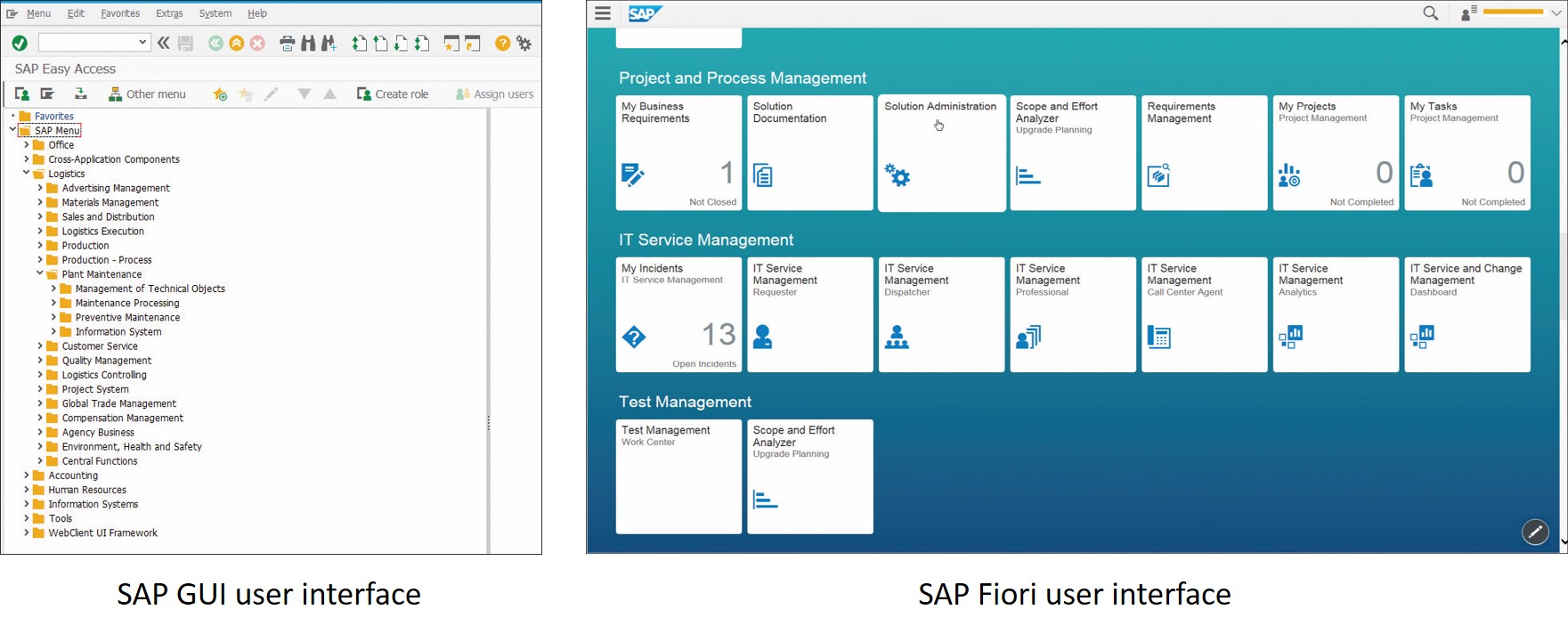
SAP is constantly adding and improving functionality for its solutions, but there are a host of ways users themselves can add customizations to fit their unique needs and perform routine data management and administration tasks. Therefore it’s important to understand a little more about the technical aspects of SAP solutions.
SAP allows its customers to customize its solutions and offers a host of extensibility options for users to take advantage of. This extension can range from the simple modification of existing application code to the creation of brand-new applications that run directly on or alongside an SAP system.
Developers can choose, depending on the goal they’re looking to accomplish, from a host of coding languages when building applications with SAP. This includes Java, SQL and SQLScript, JavaScript, and HTML5 (SAPUI5). The most oft-used language, however, is the SAP-developed Advanced Business Application Programming (ABAP) language.
ABAP is a multi-paradigm programming language, meaning programmers can utilize general principles such as procedural or object-oriented programming. Developers can also make use of two ABAP-specific programming models: the ABAP programming model for SAP Fiori and ABAP RESTful programming model.
SAP has a robust cloud portfolio of apps that allows users to work on the go. And what isn’t naturally (or “natively”) mobile can likely be made mobile with the help of a developer and the platform-as-a-service SAP Business Technology Platform (formerly SAP Cloud Platform). SAP also provides a handful of software development kits (SDKs) to help programmers extend SAP ERP and SAP S/4HANA.
Quite often organizations utilize both SAP and non-SAP systems to do business. SAP offers a host of integration options with solutions such as SAP Process Orchestration, SAP Integration Suite, SAP Gateway, and SAP S/4HANA extensions such as adding custom fields or CDS views.
Additionally, SAP has created various tools for interfacing with non-SAP systems, such as Business Application Programming Interfaces (BAPIs), electronic data interchanges (EDIs), intermediate documents (IDocs), and application link enabling (ALE). SAP is also compatible with OData.
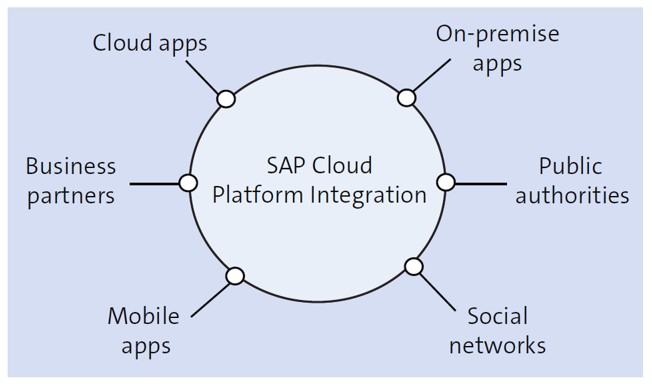
Those who have made the decision to utilize SAP find themselves with a host of administration options to utilize. For example, SAP Solution Manager (known colloquially as “SolMan”) is used across the SAP landscape to help maintain the system and keep it running securely, cleanly, and smoothly. With this tool, administrators will get the help they need in everything from monitoring user access and assigning authorizations to managing change control and IT services. It is currently on release 7.2.
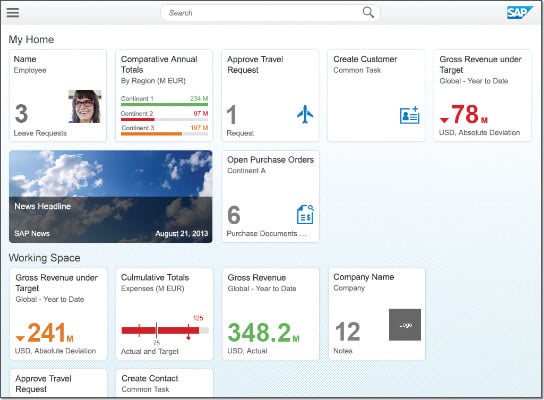
SAP Cloud ALM comes pre-loaded with guidance from SAP powered by content from the SAP Activate methodology, along with processes from the Enterprise Architecture Reference Library. The product helps you not only in implementations, but also in your operations and service deliveries.
A set of SAP HANA tools is also available for maintaining that database and platform. This includes options such as SAP HANA Cockpit, SAP HANA Studio, SAP HANA XS Administration Tools, and SAP HANA Lifecycle Manager.
Other tools that allow you to provision and clean data, manage information and databases, ensure security and data privacy compliance, and manage user access are available to SAP users.
SAP operates in multiple industries, each with its own lexicon. However, you’re likely to come across certain terms that span these industries during your time using SAP solutions. Let’s take a look at some of the most common.
Transaction code: An alphanumeric shortcut used for performing a specific task in SAP ERP. Also referred to as a t-code. Their SAP S/4HANA counterparts are SAP Fiori apps.
During the early twenty-first century when SAP was rapidly releasing and acquiring products, in addition to adding or changing available functionality it would occasionally rename them to better fit into its product portfolio. Below are two lists of old SAP product names that will help should you come across one.
Learn more SAP from our official Learning Center.
And to continue learning even more about SAP, sign up for our weekly blog recap here: